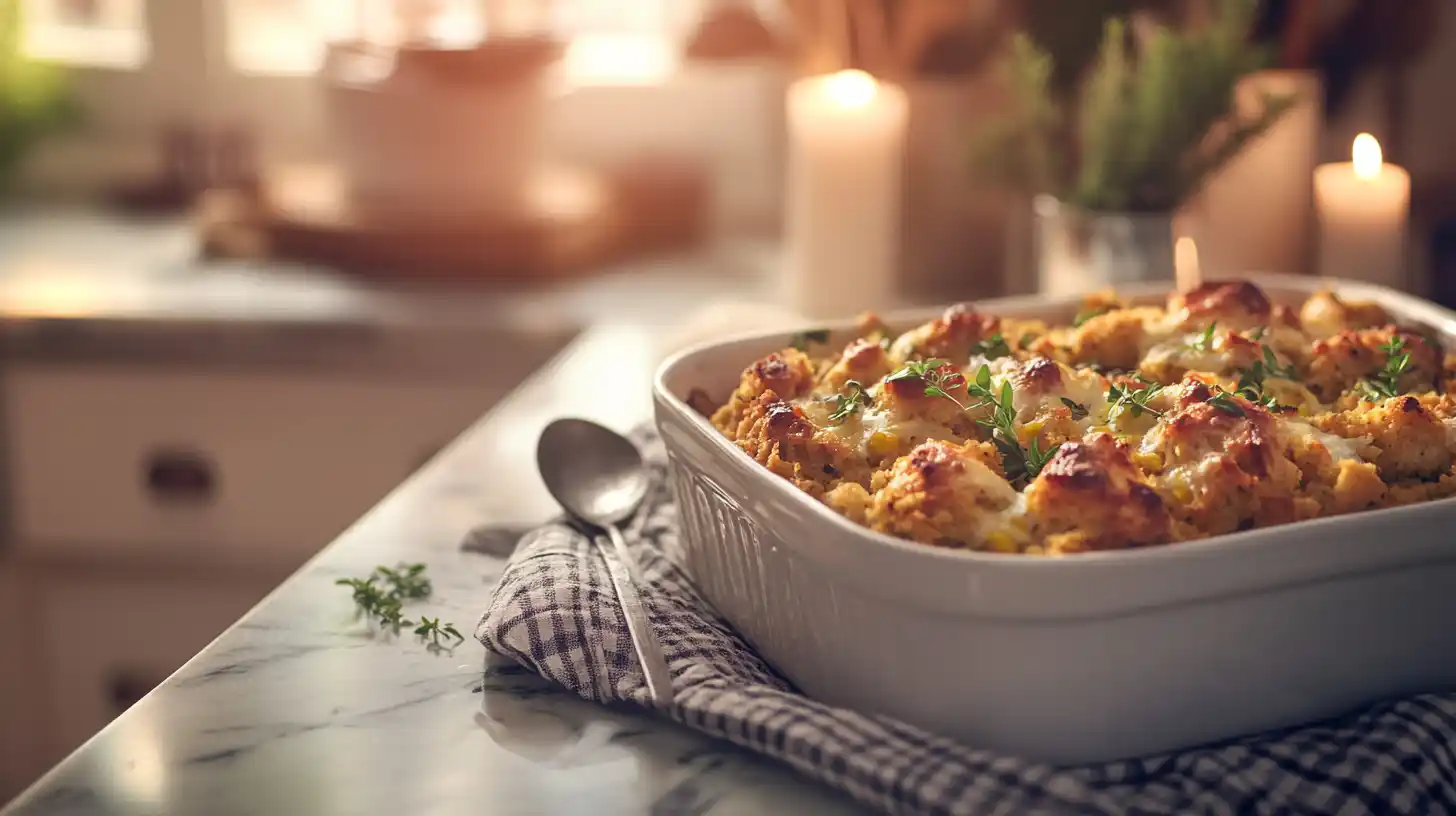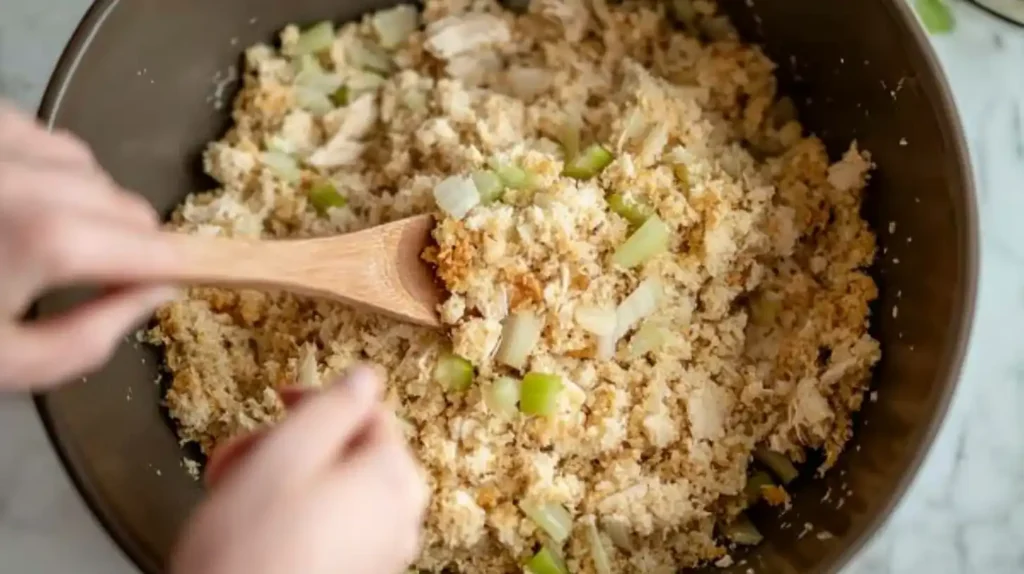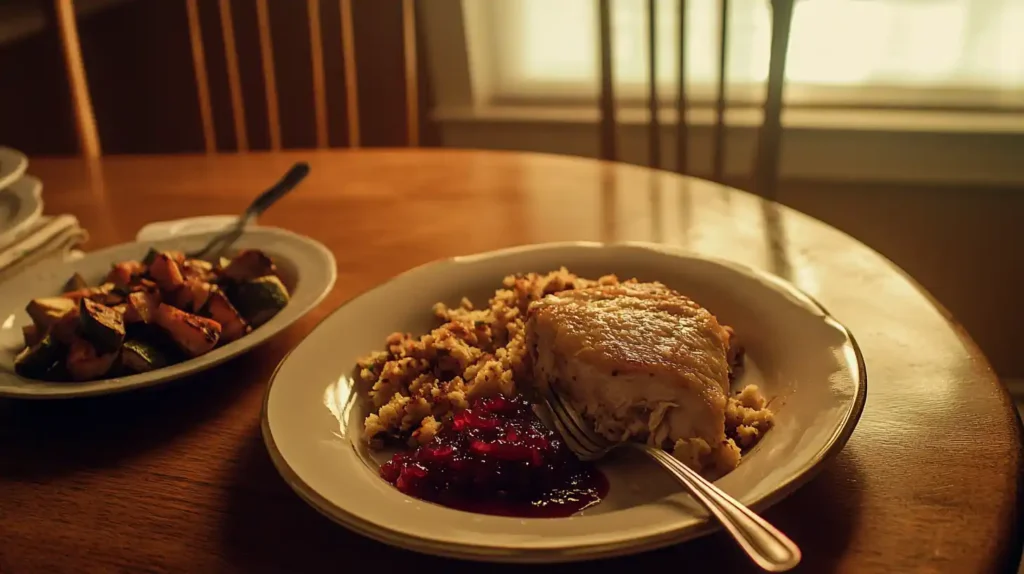Last updated on: January 27, 2025

Table of Contents
When it comes to comfort food, few dishes hold a candle to the beloved chicken and dressing recipe. It’s a staple in Southern kitchens, cherished for its rich, savory flavor and nostalgic appeal. Whether you’re preparing it for Thanksgiving, Christmas, or just a cozy Sunday meal, this dish brings family and friends together around the table.
In this comprehensive guide, we’ll explore the history and cultural significance of chicken and dressing, dive into essential ingredients, and provide step-by-step instructions to create the perfect dish. We’ll also explore variations, pro tips for success, and FAQs to help you master this classic. Ready to roll up your sleeves and get started? Let’s dig in!
What is Chicken and Dressing?
The Origins of Chicken and Dressing
The roots of chicken and dressing run deep in Southern traditions. Historically, dressing evolved from stuffing—a practice of filling poultry with seasoned bread before roasting. Over time, the dish became a standalone side, and in the South, cornbread became the key ingredient. Unlike stuffing, which is cooked inside the bird, dressing is baked in a casserole dish, allowing it to develop a golden, slightly crisp crust.
Cultural Significance in Southern Cooking
For many Southerners, chicken and dressing is more than just a recipe—it’s a connection to generations past. This dish often graces holiday tables and family gatherings, symbolizing warmth, togetherness, and culinary heritage. The moist, flavorful combination of shredded chicken, cornbread, and aromatic spices is comfort food at its finest.
Difference Between Dressing, Stuffing, and Filling
Though the terms are sometimes used interchangeably, there are subtle differences. In the U.S., dressing refers to a bread-based side dish baked separately, while stuffing is cooked inside poultry. Meanwhile, filling is more common in Pennsylvania Dutch cuisine and often includes potatoes or noodles. Regardless of the name, the essence of this dish lies in its savory flavor and heartwarming appeal.
Essential Ingredients for Chicken and Dressing
Traditional Ingredients Used
A classic chicken and dressing recipe is all about simplicity and bold flavors. The key ingredients include:
- Cornbread: As the foundation of Southern dressing, cornbread lends a crumbly texture and slightly sweet undertone. Homemade cornbread is preferred, but store-bought works in a pinch.
- Broth and Chicken: Tender shredded chicken and rich broth add depth and moisture to the dish. Using homemade chicken broth elevates the flavor.
- Vegetables: Sautéed celery and onions are a must, providing aromatic balance and a slight crunch.
- Seasonings: Sage, thyme, black pepper, and a touch of salt create a savory, comforting taste that’s undeniably Southern.
Optional Additions and Variations
Dressing is a wonderfully versatile dish, and you can add ingredients to suit your taste:
- Sausage or Bacon: Add a smoky, savory kick by including cooked sausage or crispy bacon bits.
- Herbs and Spices: Experiment with fresh parsley or rosemary for a unique flavor twist.
- Vegetarian Substitutes: Replace chicken with roasted mushrooms or tofu, and use vegetable broth for a plant-based version.
Cooking with fresh ingredients ensures maximum flavor. If you’re preparing holiday meals, consider pairing this dish with a sweet potato side like sweet potato cornbread.
Step-by-Step Recipe for Classic Chicken and Dressing

Preparing the Cornbread
Start with freshly baked cornbread, the heart of this dish. If time allows, let it rest overnight so it’s slightly dry—this helps it absorb more broth without becoming mushy. Crumble it into fine pieces and set aside.
Cooking the Chicken and Making the Broth
Boil chicken thighs or breasts until tender. For richer flavor, add a bay leaf, garlic cloves, and a few peppercorns to the water. Once cooked, shred the chicken and reserve the broth. Using homemade broth adds a level of depth that store-bought simply can’t replicate.
Combining Ingredients for the Dressing
Sauté diced celery and onions in butter until softened. In a large bowl, mix the crumbled cornbread, shredded chicken, sautéed vegetables, and a blend of seasonings like sage and thyme. Gradually stir in the broth until the mixture reaches a moist but firm consistency.
Baking the Chicken and Dressing
Spread the mixture into a greased casserole dish. Bake at 375°F for 30-40 minutes, or until the top turns golden brown and slightly crispy. The aroma of sage and cornbread will fill your kitchen, making it irresistible to wait for dinner!
Serve your chicken and dressing recipe hot with a side of gravy or cranberry sauce for a holiday-worthy meal. Pair it with other Southern favorites like creamy mushroom chicken and rice for a satisfying feast.
Variations of Chicken and Dressing Recipes
Cornbread-Free Options
If you’re not a fan of cornbread or simply want to try something new, there are plenty of alternatives. Swap the cornbread with day-old French bread, sourdough, or even biscuits for a different texture and taste. This variation works wonderfully for those who enjoy a denser, chewier dressing. Additionally, you can mix in cooked wild rice or quinoa for an earthy twist that adds a nutty flavor and boosts the dish’s nutritional value.
Gluten-Free or Keto Chicken and Dressing
For a gluten-free version of the chicken and dressing recipe, substitute cornbread with gluten-free bread or almond flour-based cornbread. Ensure your chicken broth is also certified gluten-free. Keto enthusiasts can opt for a low-carb cornbread made from almond flour or coconut flour. Pair it with additional protein like diced turkey or sausage for a meal that’s both hearty and compliant with dietary restrictions.
Vegetarian Alternatives
Who says dressing is only for meat lovers? A vegetarian version of this classic dish can be just as delicious. Replace the chicken with roasted mushrooms, which offer a meaty texture and savory flavor. Use vegetable broth instead of chicken broth, and consider adding nuts like pecans or walnuts for an extra crunch. This is a great option for including plant-based eaters in your holiday feast.
For even more creative comfort food ideas, explore our guide to making cowboy cornbread casserole, another versatile dish that can cater to a variety of preferences.
Tips for Perfect Chicken and Dressing
How to Achieve the Right Consistency
The secret to the perfect chicken and dressing recipe lies in achieving the ideal consistency. Your mixture should be moist but not soggy. Add broth gradually, stirring after each addition to check the texture. If it’s too wet, the dressing won’t hold together during baking; too dry, and it’ll crumble on your fork. Aim for a thick, pudding-like texture before transferring it to the baking dish.
Common Mistakes to Avoid
Even seasoned cooks can run into trouble with dressing. Here are some pitfalls to avoid:
- Overmixing: Stirring too much can make the dressing gummy. Combine ingredients just until they’re evenly distributed.
- Skipping the Seasoning: A bland dressing is disappointing. Taste-test the mixture before baking and adjust spices as needed, especially sage and black pepper.
- Not Baking Long Enough: Dressing needs time to develop a golden crust while heating through. If it’s browning too quickly, cover with foil and bake a little longer.
Best Practices for Moist Dressing
- Use homemade broth if possible—it’s more flavorful and less salty than store-bought versions.
- Don’t skimp on butter. Adding melted butter to the mix or dotting it on top before baking helps lock in moisture and enhances flavor.
- Bake the dressing uncovered for the first 20 minutes, then cover it with foil to retain moisture while it finishes cooking.
For additional holiday inspiration, try our recipes for old-fashioned sweet potato casserole, a perfect side to complement your dressing.
Next, we’ll address FAQs about chicken and dressing and provide serving and storage tips to complete your culinary journey!
FAQs About Chicken and Dressing
What is Dressing in the South?
In the South, dressing refers to a baked bread-based side dish that’s often paired with poultry, especially during the holidays. Unlike stuffing, which is cooked inside a bird, dressing is prepared in a separate casserole dish. Traditional Southern dressing relies heavily on cornbread, seasoned with herbs like sage and thyme for a rich, savory flavor. This distinction is a point of pride in many Southern households, where the chicken and dressing recipe is a cherished family tradition.
What is Dressing in Chicken?
Dressing in chicken typically means a flavorful mix of crumbled bread, spices, and vegetables, cooked alongside shredded or baked chicken. The chicken adds protein and heartiness, while the dressing provides a soft, crumbly texture that’s perfect for soaking up gravy. In some variations, the chicken is layered on top or mixed directly into the dressing for a cohesive casserole-style dish.
What is the Difference Between Stuffing, Filling, and Dressing?
While these terms are sometimes used interchangeably, their meanings vary depending on geography and preparation. Stuffing is cooked inside poultry, absorbing juices as it bakes. Dressing is baked separately, often using cornbread in Southern recipes. Meanwhile, filling is common in Pennsylvania Dutch cuisine and may include ingredients like potatoes or noodles for a denser dish.
How Long is Chicken and Dressing Good For?
Properly stored in an airtight container, chicken and dressing can be refrigerated for up to 3-4 days. Reheat it in the oven or microwave to restore its texture. For longer storage, freeze the dressing for up to 3 months. Be sure to thaw it overnight in the fridge before reheating.
Serving and Storing Chicken and Dressing

Serving Suggestions for Holiday Meals
This chicken and dressing recipe is the perfect centerpiece for any holiday meal. Serve it warm with a generous drizzle of gravy or cranberry sauce on the side for a festive touch. Pair it with roasted vegetables, mashed potatoes, or green bean casserole to create a complete, comforting spread. Don’t forget to include dinner rolls to help scoop up every last crumb!
How to Reheat Without Drying Out
Reheating leftover dressing can be tricky if you want to keep it moist and flavorful. For best results, place it in a baking dish, add a splash of broth or melted butter, and cover it with foil. Bake at 350°F for about 15-20 minutes, or until heated through. In a rush? Use the microwave, but cover the dish with a damp paper towel to retain moisture.
Freezing Tips for Make-Ahead Dressing
Planning ahead? This chicken and dressing recipe freezes beautifully. To freeze, assemble the dressing without baking it. Wrap the dish tightly in plastic wrap, then cover with aluminum foil to prevent freezer burn. When ready to serve, thaw it in the fridge overnight and bake as directed, adding a little extra broth if needed to refresh the texture.
By following these tips, you’ll always have a delicious dish ready to impress your guests! Up next, we’ll wrap up this guide with some final thoughts on why chicken and dressing remains a classic crowd-pleaser.
Conclusion and Final Thoughts
Why Chicken and Dressing is a Comfort Food Classic
The chicken and dressing recipe has stood the test of time for good reason—it’s the epitome of comfort food. Its hearty, flavorful blend of tender chicken, crumbly cornbread, and savory herbs evokes a sense of home and tradition. For generations, families have gathered around tables to share this dish during holidays and special occasions. It’s more than a recipe; it’s a memory-maker, a dish that tells a story with every bite.
Encouragement to Experiment with the Recipe
What makes this dish even more special is its versatility. Whether you stick to the traditional Southern recipe or explore variations to suit dietary needs or flavor preferences, there’s endless potential to make it your own. Add unexpected ingredients, adjust the spices, or experiment with textures—each version brings a unique twist to this classic. So, roll up your sleeves, get creative, and let your kitchen become the heart of your home.

